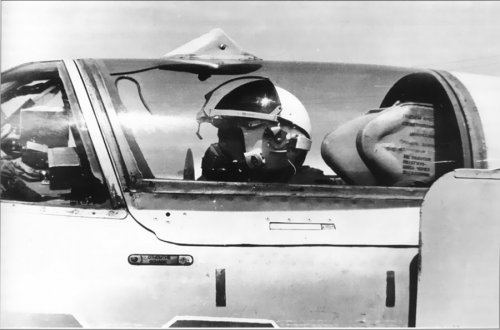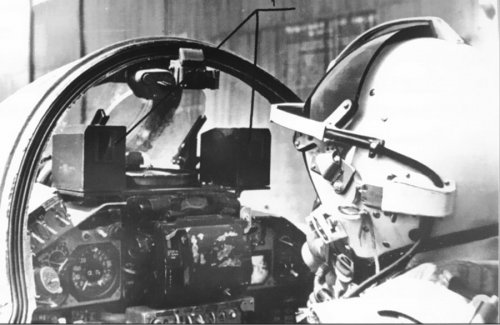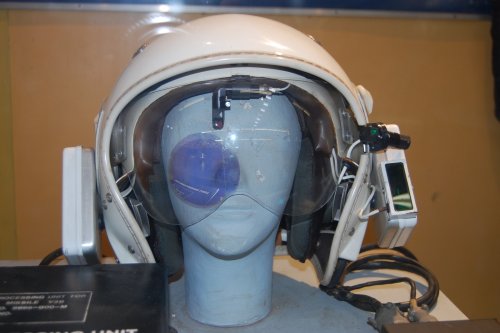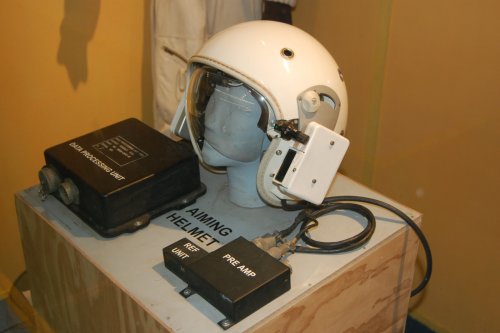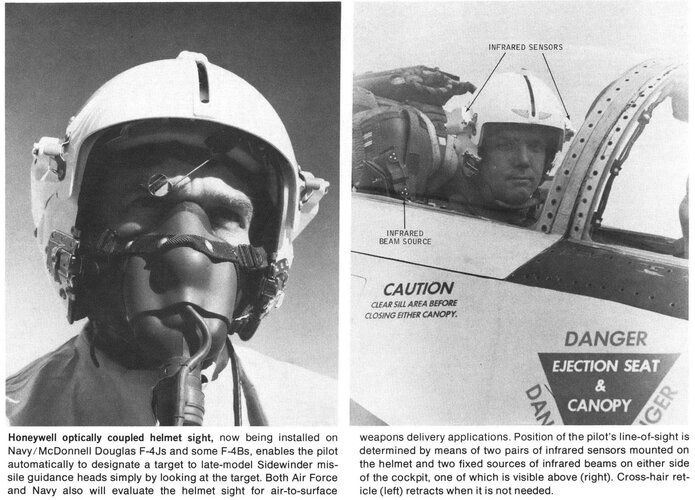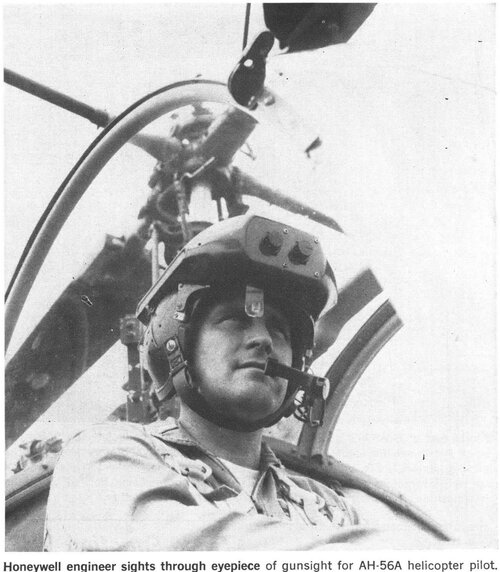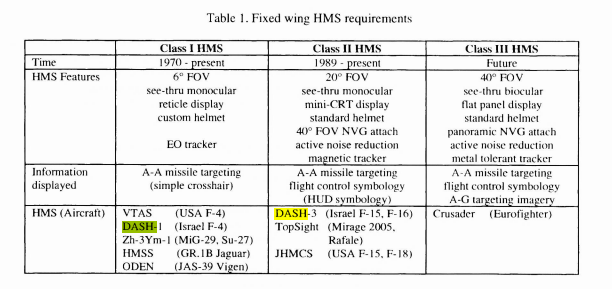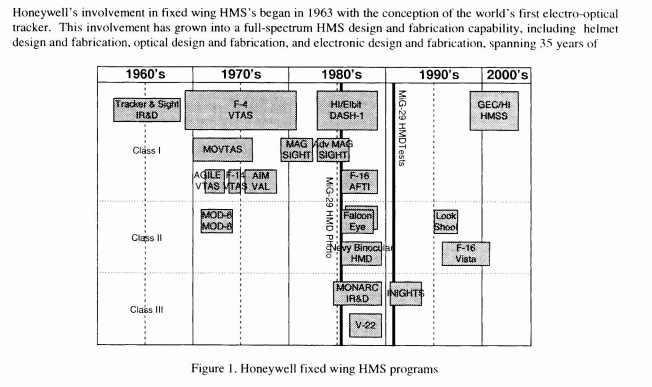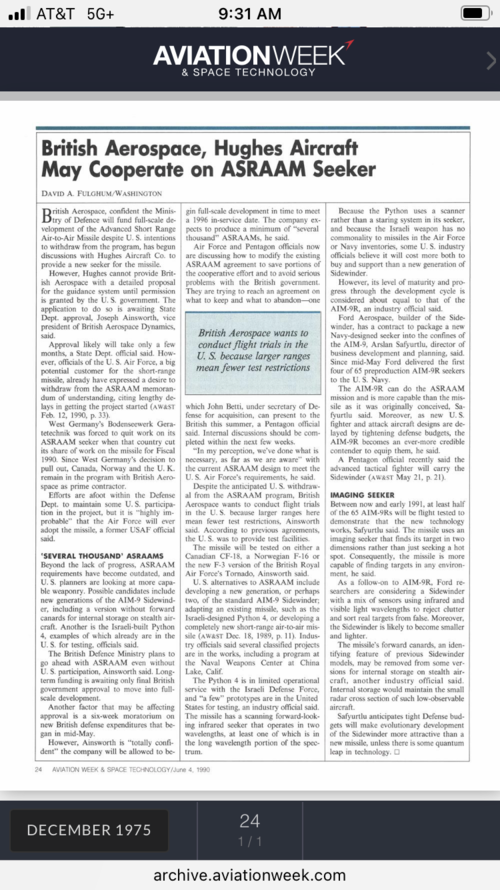Publication Logo
Aviation Week & Space Technology
April 4, 1977
Fighter, Missile Gains Pressed
BYLINE: By Clarence A. Robinson, Jr.
SECTION: MANAGEMENT; Pg. 12
LENGTH: 2219 words
DATELINE: Las Vegas
HIGHLIGHT: Navy, USAF joint test in Nevada spurs advances in tactics, seeker sensitivity, avionics requirements for next decade
Navy and Air Force fighter aircraft tactics, air-to-air missile seeker sensitivity and aircraft avionics requirements for the next decade are expected to emerge from a highly unorthodox test being conducted jointly by the two services at Nellis AFB, Nev.
The $55-million test program is the air intercept missile evaluation/air combat evaluation and is known by the acronym Aimval/Aceval. Located at Nellis AFB, 10miles north of this city, is the Cubic Corp.'s air combat maneuvering instrumentation system designed to provide realistic air-to-air training with simulated missile firing.
An advanced version of the earlier Navy air combat maneuvering range, the instrumentation system is used in a 40-naut.-mi.-dia. area in the desert north of Nellis to provide realtime data on aerial combat taking place here on a daily basis.
Tactics evolving from the simulated dogfighting are already flowing to squadrons in both services. The USAF/McDonnell Douglas F-15 and Navy/Grumman F-14 are pitted against a common foe -- the Northrop F-5E used to simulate the Soviet MiG-21 Fishbed fighter. Performance characteristics of the F-5E closely approximate the USSR fighter.
Both services have selected the most highly qualified fighter pilots available for the test, and this includes the F-5E aggressor force comprising pilots from both services. The aggressor, or Red, aircrews are highly trained and are considered the equivalent of combat-experienced Israeli pilots, according to test officials.
The aerial combat is free play, requiring visual identification of targets before an attack can be initiated. To keep both Blue Force friendly pilots and Red Force pilots honest in visual target acquisition, intruder aircraft are flown through the combat maneuvering area on a random basis while dogfights are in process.
Both Red and Blue Force pilots are forced to engage a numerically superior enemy force at least 50% of the time, and the numbers range from one on one to two on one. Within the aerial combat scenarios, as many as four fighters engage four aggressor aircraft on the range.
Despite the excellent data being extracted from the test, according to officials in both services, there is an effort afoot to halt or at least delay the test.
Analysts from both services are questioning whether there is a problem with some of the seeker sensitivity data being generated from the missile evaluation portion of the program. Service officials, however, believe that while there may be a question about the seeker sensitivity data it would affect only 10% of the combat engagements in the test.
"The best way to handle the problem, if there is one, is to manipulate the data to cover the seeker problem, not halt the test," one official said. "We are learning more about aerial combat than we ever dreamed possible."
Other officials are convinced that the attempt to delay or halt the test is related to an effort to invalidate it because one of the fighters is not meeting its pre-test service projections about its capability.
One of the major problems in conducting this type of a flight test is that the immediate tendency is to make a comparison between the F-15 and the F-14 because both fighters are flying against a common foe. The test is not designed for this purpose, and even after all of the data have been analyzed, a comparison between the two aircraft will not be possible, test officials emphasized. What is being determined by the aerial combat simulation is that both aircraft are exhibiting superior performance, and that both have some problems that need to be corrected.
The test is divided into two phases taking place over a 10-month period. The air intercept missile phase is scheduled to be completed in early June, with a final report for the air combat evaluation portion scheduled for December.
More than 4,000 sorties will have been flown here before the test is concluded, and both friendly and aggressor pilots have been honing their skills for almost a year with daily flights, including a warm-up period leading up to the test.
The missile phase of the test includes:
* Defining requirements for future short-range air-to-air missiles.
* Evaluation of five infrared missile concepts.
Because of the intensity of aerial combat necessary to complete the missile evaluation, some of the aerial combat evaluation data will be gleaned from the missile evaluation.
During the air combat evaluation, the Pentagon and the two services expect to determine the relative effectiveness of opposing fighters and to provide data for deciding on future fighter force structure and composition.
the missile portion of the test is being flown to determine if the two services can use a common air-to-air missile and, if so, what degree of offboresight capability is required and what degree of seeker sensitivity. In developing a missile to replace the AIM-9L advanced Sidwinder, the Navy pressed for the Agile missile with a large offboresight capability and thrust vector control. The air force wanted a low-cost lightweight missile.
Congress denied both programs and told the two services to pursue a joint missile definition program. The missile phase of the test is to determine what will be required in the missile.
Both of the services have developed seeker heads to support the test, and the seekers are being captive-carried on both the F-15 and the F-14 with simulated firings against the aggressor aircraft to determine the seeker capability in a variety of air maneuvering situations.
The aggressor F-5Es are armed with the Raytheon AIM-9L, which simulates the all-aspect seeker sensitivity that the USSR could have available in the Atoll missile through the 1980s.
USAF's conceptual missile is called the SS-1 and is being evaluated in the dogfight tests using two modes of acquisition labeled Concept A and B. The two concepts are identical except for target acquisition.
Ford Aerospace has produced the SS-1 captive test unit for USAF, and Concept A utilizes boresight acquisition while B has a higher off-boresight capability, up to + -30 deg.
For the Nellis test, both the A and B concepts are represented by a cruciform-configured, canard-controlled missile with a seeker sensitive to a single color in the optical spectrum.
The tracker is a conventional free gyro/precession coil employing lead bias. Missile performance is in an envelope that includes an all-aspect capability against an afterburning target, and nearly all-aspect against an aircraft in a military power setting.
USAF accepted the limited forward aspect capability as a trade for reduced cost, manpower, equipment support and increased reliability from the elimination of gas cryogenics.
Employment of the SS-1 is characterized by:
* Multiple missile carriage, with up to eight missiles on the fighter. for the test eight missiles are simulated.
* Simultaneous automatic acquisition.
* Pilot consent automatic sequential launch.
In the Concept A mode, the pilot must maneuver his aircraft to place the target within the caged seeker field of view. The pilot has a circular scan function available that can be selected by depressing the scan button on the throttles. When the pilot depresses the weapon release button, all the missiles are premitted to lock-on and track the target.
The first missile within the normal launch sequence to lock on, determined by a signal above the target signal-to-noise ratio, is automatically fired. Other missiles are automatically launched at 1.5-sec. intervals if locked on and the release button is depressed by the pilot. If a missile is not locked on it will not launch.
If the weapon release button is released at any time by the pilot, the launch sequence is stopped. When the button is released all missile that are locked on are recaged to the boresight position.
The Concept B missile functions the same way, except that the seeker can be slaved to an acquisition and the Northrop visual target acquisition system or radar for off-boresight acquisition up to 30 deg. When the launch sequence is stopped, the seeker returns to alignment with the acquisition aid rather than to the boresight position.
The B concept's scan mode also is different. Circular scan is available while the seeker is in the slave mode. When not slaved to an acquisition aid and scan is selected, the scan pattern becomes vertical through the position.
The Navy captive test unit is the SS-2 and encompasses two variants, the D1 and D2 missile concepts, Both are based on heads-up, high off-boresight angles, target designation and slaving the seekers.
The visual target acquisition system is the basic method used for off-boresight target acquisition and supplements other aircraft acquisition modes.
The D1 seeker has about the same acquisition sensitivity as the AIM-9L seeker, while the D2 has increased sensitivity, providing longer detection ranges than present short-range, air-to-air missiles. This is particularly true in the head-on/forward quarter aspects. The off-boresight capability of 70 deg. for both the D1 and D2 seekers is designed for use against the projected threat armed with the equivalent of the AIM-9L in the 1980-1990 period.
The captive test units are mounted on both the F-14 and F-15 for the test, using modified LAU-7A missile launchers on pylons on each side of the aircraft. When either of the D concept modes is employed in the test, each aircraft carries two SS-2s, which will simulate four missiles.
Concept D1 and D2 captive test units are medium wavelenght infrared seekers mounted on a aluminum/steel airframe. Electronics, power supply and interface unit are contained within the 6.5-in. dia. airframe.
The seeker employs a three-axis gimbal system with a rotating optical telescope derived from the Agile missile program.Hughes Aircraft Co. produced the D1 and D2 seekers for the test. A translucent infrared dome is constructed from a hemisphere mated to a cylinder, allowing seeker viewing angles up to gimbal limits.
A single color-crossed array detector is used in conjunction with the rotating optical telescope to produce tracking errors. The error signals are processed by teh guidance and control group and drive the gimbal system to maintain track.
Seeker field of view is 3.7 deg. along the principal axes of the detector array. The detector is cooled with argon gas supplied through an umbilical harnessed to a gas bottle on the LAU-7A launcher.
Seeker lock-on and launch is accomplished using two methods -- normal and quick fire. The aircrew receives both visual and audio cues when the seeker is locked on. With the seeker locked on, the aircrew activates the missile firing switch to simulate missile launch.
Using the visual target acquisition system, an illuminated helmet-mounted sight reticle remains lighted constantly until the offboresight angle limits are exceeded.The reticle blinks at a 2 cycles/sec. rate when the angle has been exceeded.
The reticle blinks at an 8-cycle/sec. rate at lock-on when the target is within the off-boresight angle limit. Audio cues are used to denote target detection and lock-on. The synthetically generated tone is produced when the present infrared threshold is exceeded. In the D1 concept it is similar to the AIM-9L threshold, and lowered for greater sensitivity with the D2.
The F-5E aggressor aircraft in the test are configured with an AIM-9L training missile mounted on the right wingtip launcher rail with an airborne instrumentation subsystem pod for the air combat maneuvering range system mounted on the left wingtip launcher rail.The training AIM-9L can only be operated in a boresight, nonscan mode for acquisition.
The Block 90 F-14As taking part in the test required extensive hardware and software changes.They include:
* Maneuvering slats. Slat extension/retraction occurs concurrently with selection of maneuvering flaps.
* Central air data computer with high angles of attack, the flight stick utilizes rudder instead of differential stabilizer for roll control.
* Second UHF radio, replacing the ARC-51 with the ARC-150 (V)5 solid-state radio for a 20-w. output increase.
* Lower pylon Sidewinder adapter.Stations 1B and 8B can carry the AIM-9L missile.
The Honeywell visual target acquisition system -- a dual cockpit system -- has been installed by Hughes. Both the pilot and flight officer are able to slave the missile seekers off-boresight with the visual target acquisition system. All seekers slave to either crewmember's line of sight. The pilot is dominant if simulataneous slaving occurs in both cockpits.
The visual target acquisition system is used in the F-15 and provides target acquisition capability by determining the pilot's line of sight to the target. The system uses infrared light beams, which are generated by two transmitters and detedted by four helmet-mounted sensors. The sensors supply information to the target acquisition computer for line-of-sight computation. The line-of-sight direction as seen through the helmet sight piece is sent by the computer to the missile seeker which is slaved to the system. The system is used on the F-15 only with the Navy's D concept seekers.
URL: http://www.aviationnow.com
SERIES: This is the first in a series of articles on the joint Navy/USAF air intercept missile evaluation/air combat evaluation. Subsequent articles will appear in future issues of AVIATION WEEK & SPACE TECHNOLOGY.

